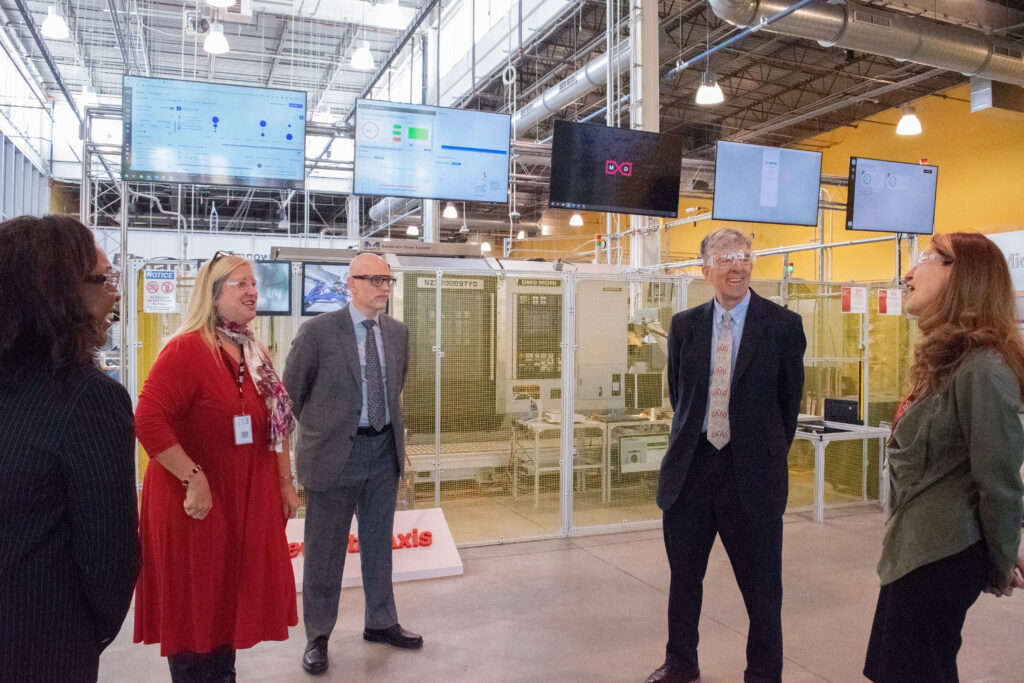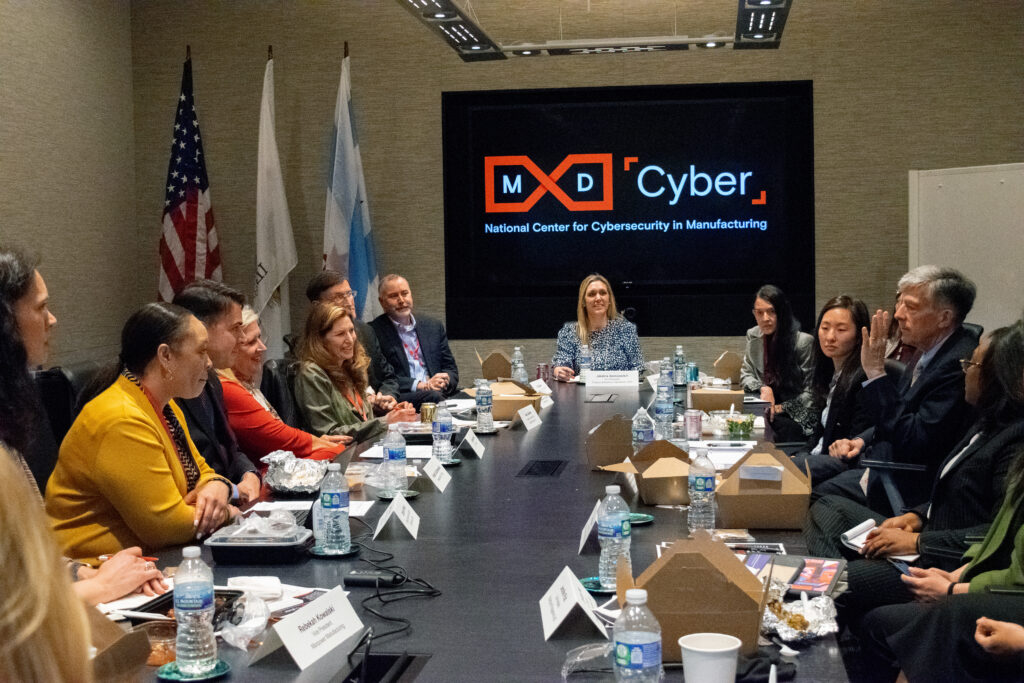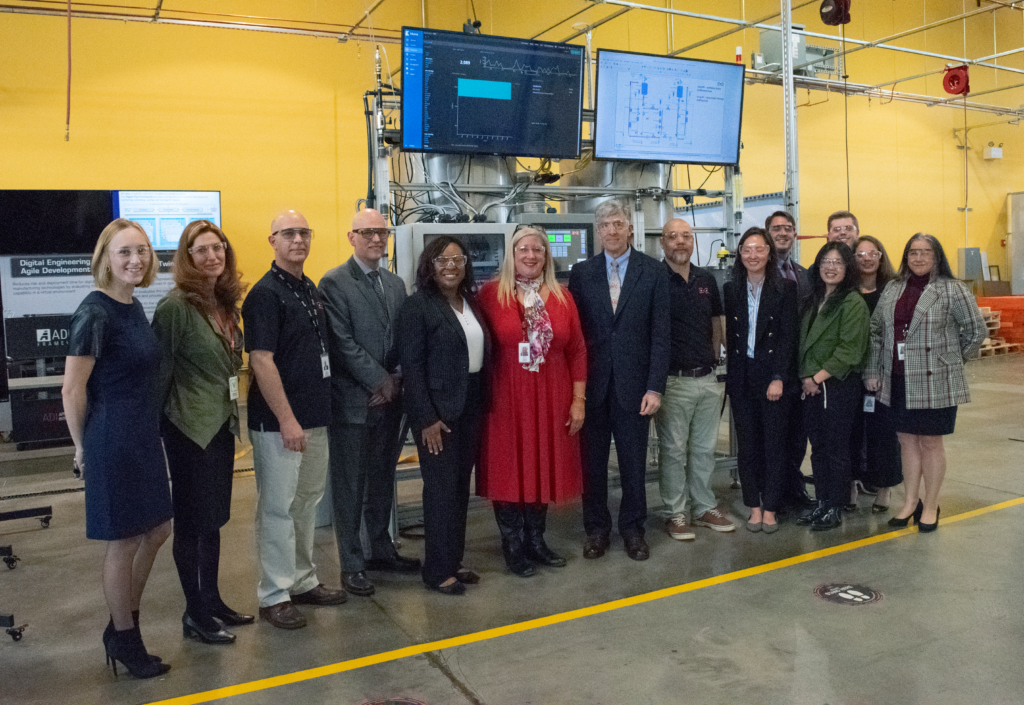According to the Statement of Strategic Intent for the Office of the National Cyber Director (ONCD), “In this world, all of us are defending each of us.” This spirit was on display as the inaugural National Cyber Director, Chris Inglis, visited MxD for a tour and roundtable discussion during a visit to Chicago this week.
CEO Chandra Brown and other members of the MxD team and Board of Directors highlighted digital manufacturing and cybersecurity concepts in action on MxD’s factory floor. As participants noted throughout the visit, the prevailing assumption that cyber-attacks are “an IT problem” increases the vulnerability of industries like manufacturing and energy production, where operational technology (OT) is more connected, and thus more vulnerable, than ever before.

To show the harm that hackers can inflict on OT, two testbeds at MxD illustrate the National Institute of Standards and Technology (NIST) Cybersecurity Framework. The pillars of this framework—identify, protect, detect, respond, and recover—are embedded in a manufacturing environment.
In its role as the National Center for Cybersecurity in Manufacturing, MxD conducts awareness initiatives to enable manufacturers to better understand cyber threats and put basic protections in place, as the first couple of pillars entail. However, the unnerving reality that cyber-attacks are virtually inevitable for manufacturers of all sizes means a proactive plan to respond and recover is equally as important.
While a personal vehicle is not 100% safe, seatbelts and airbags make a huge impact on safety—as do safe roads, traffic signals, and speed limits. Personal vigilance is, of course, essential to avoid accidents. But the infrastructure, funded both by public and private entities, lowers the possibility of catastrophe and does not place the onus entirely on individuals.
The same concepts apply in the cyber safety world. MxD’s Cyber Platform, for example, anticipates the outcome of an attack on a water treatment plant (contaminated water mixing with clean water) and proactively includes a plan to flush the system to restore safe conditions.
This again calls to mind the ONCD charter. In his remarks to roundtable participants—representing large and small manufacturers, university leadership, local government, and workforce and economic development partners—Director Inglis described a vision for a cybersecure future incorporating resiliency by design.
Within the current environment, executives struggle to connect cybersecurity investments with business goals and often feel, in the words of one roundtable participant, that they are “a company against a country.” The greatest needs for assistance as articulated by small business owners in attendance, are lowering the cost of implementation and training workers.
To revisit the metaphor, drivers are not responsible for fashioning their own seatbelts or laying asphalt. With a reasonable individual effort, they can feel generally safe on the road even though the risk is not zero. Unless the driver decides to go offroad entirely, the burden of protection is lessened by public-private investment and collaboration.
According to Director Inglis, all the roundtable participants, regardless of organization, are engaged in public service by tackling the enormous threat of cybersecurity from each of their vantage points. He encouraged not just connecting the dots but creating new dots together.

Cybersecurity enables the execution of missions of all types. For manufacturers, the economic development, national security, and job creation potential is hampered when the approach to cybersecurity is siloed, focused on IT, and disproportionately dependent on individual measures.
As the Director noted, defending IT is part of the role of a cybersecurity specialist, but defending democracy is the end game. With the leadership of the Federal government including ONCD, better and earlier integration of security and business functions in the private sector, and thoughtful development of a cyber-ready workforce, manufacturing in the U.S. can move from reactive to resilient.

See MxD’s future factory, including the Cyber Wall and Cyber Platform, on MxD’s virtual tour. Make your manufacturing environment more secure by taking an assessment, reviewing prioritized recommendations, and purchasing vetted tools on the MxD Cyber Marketplace.
